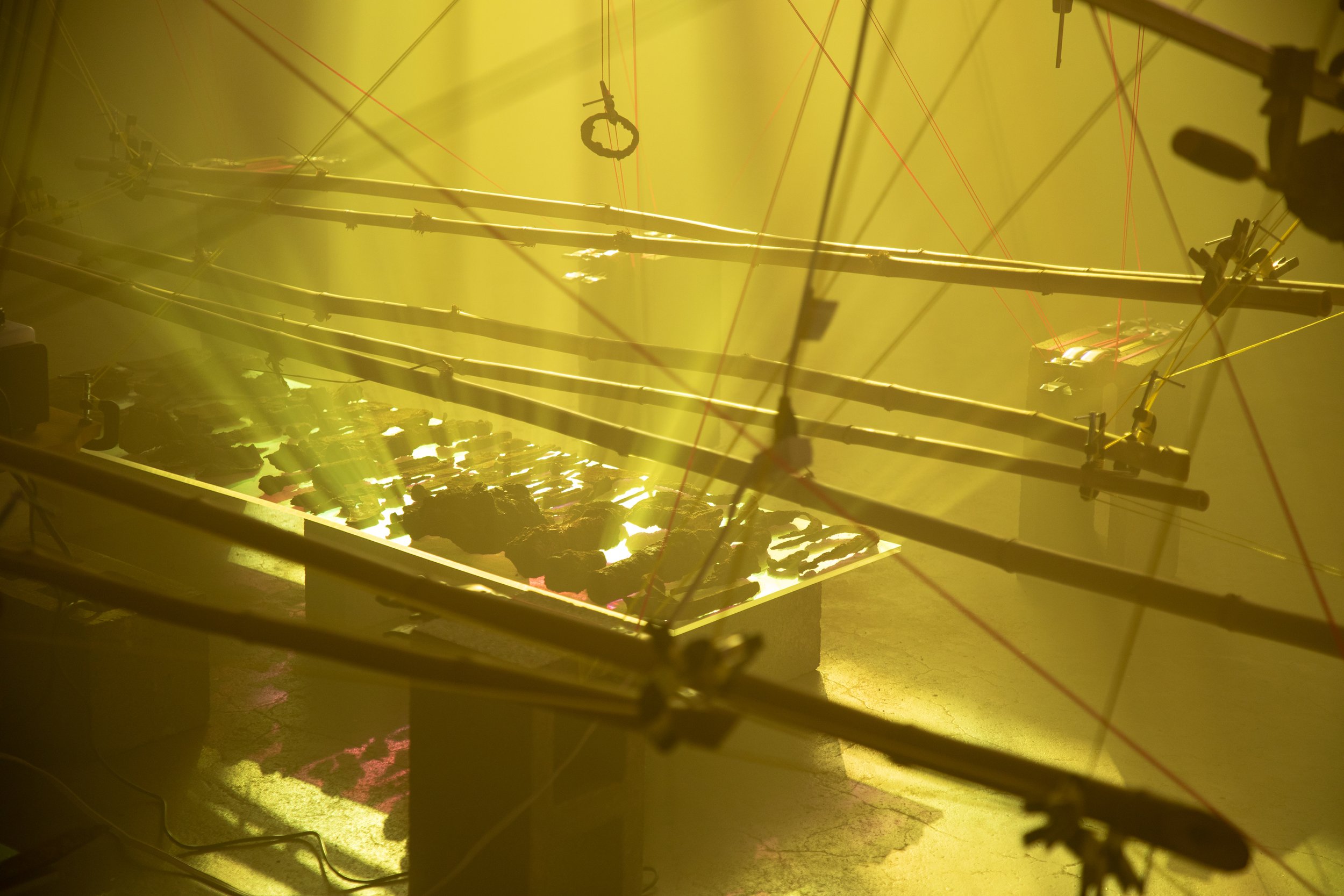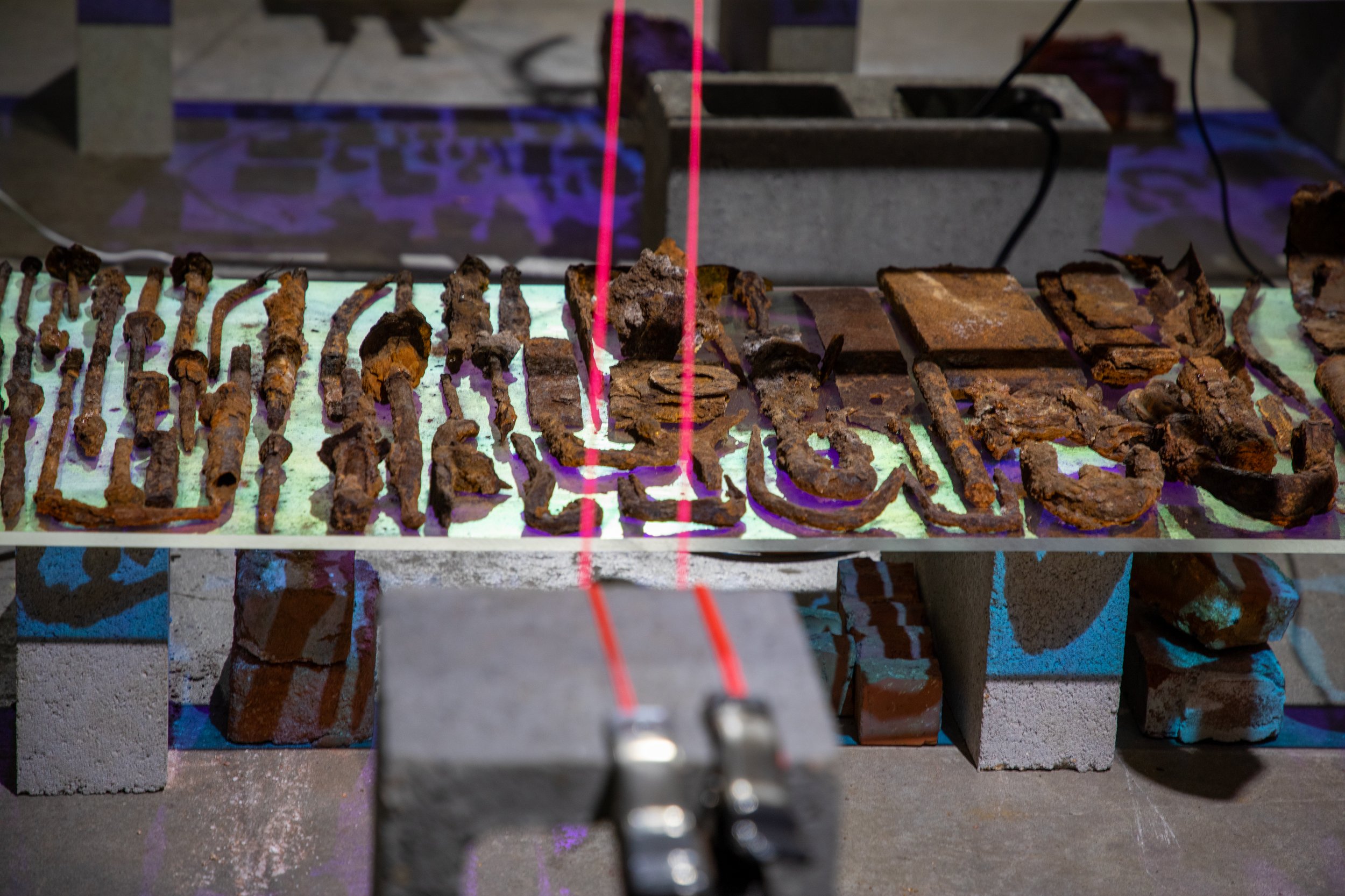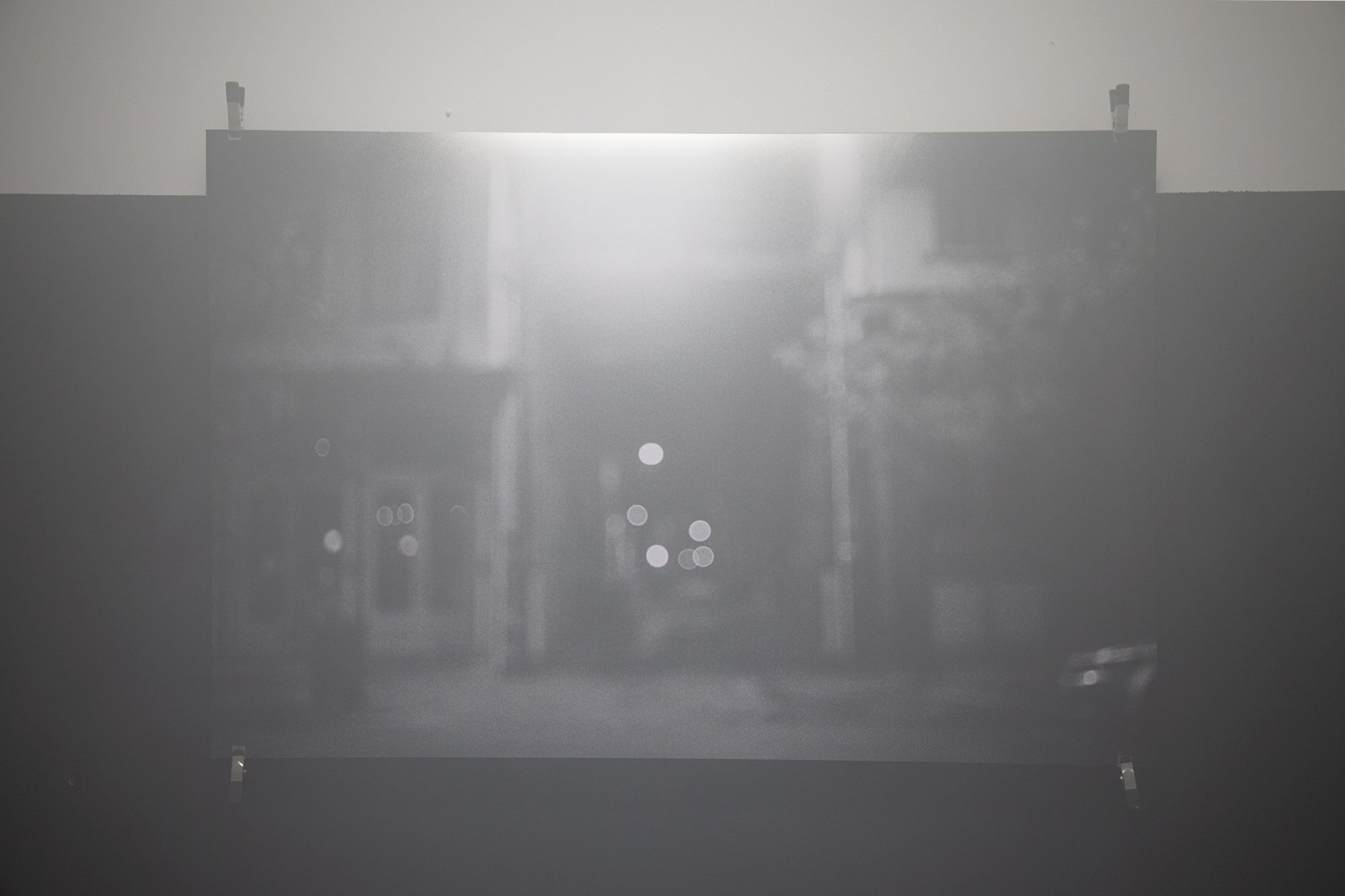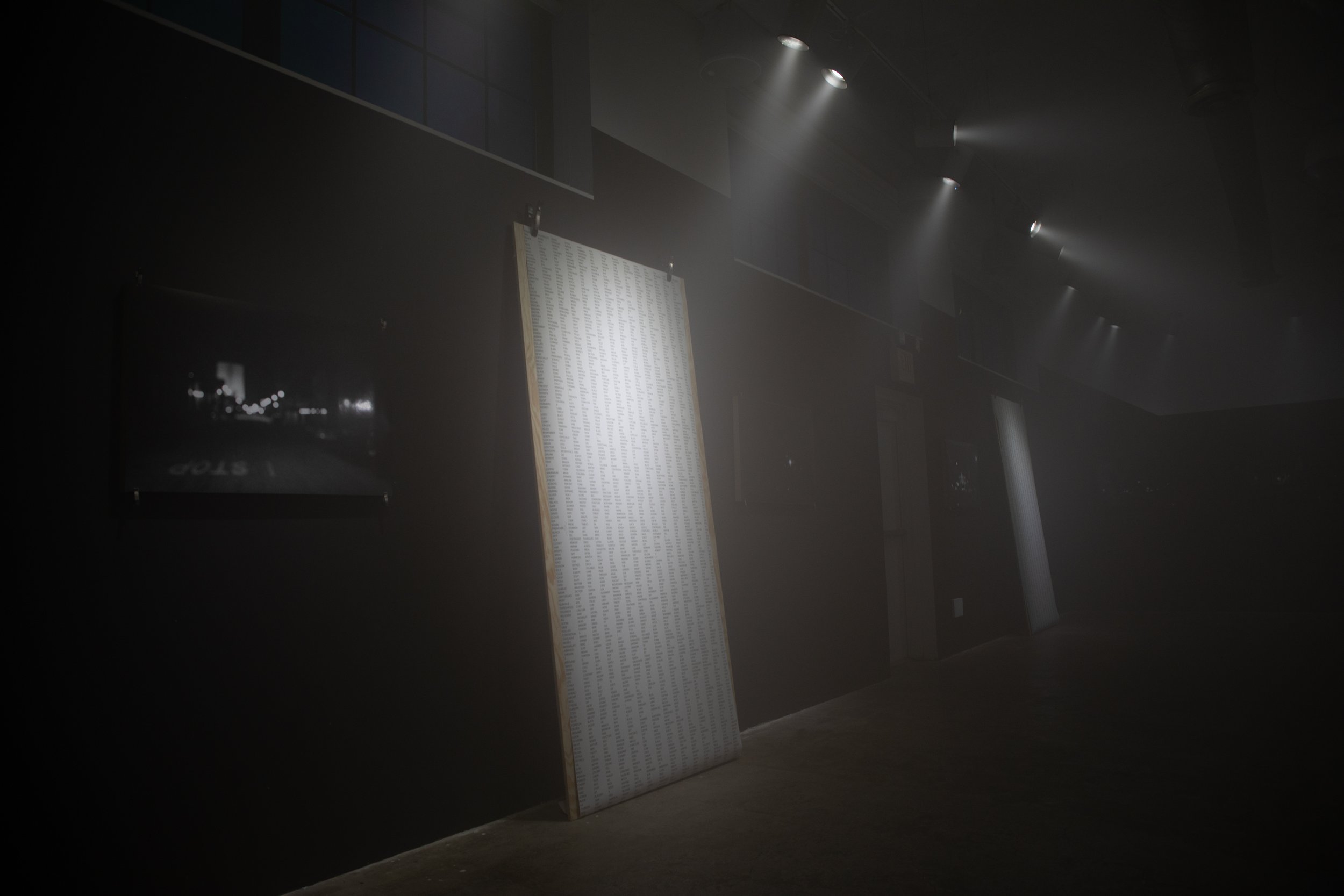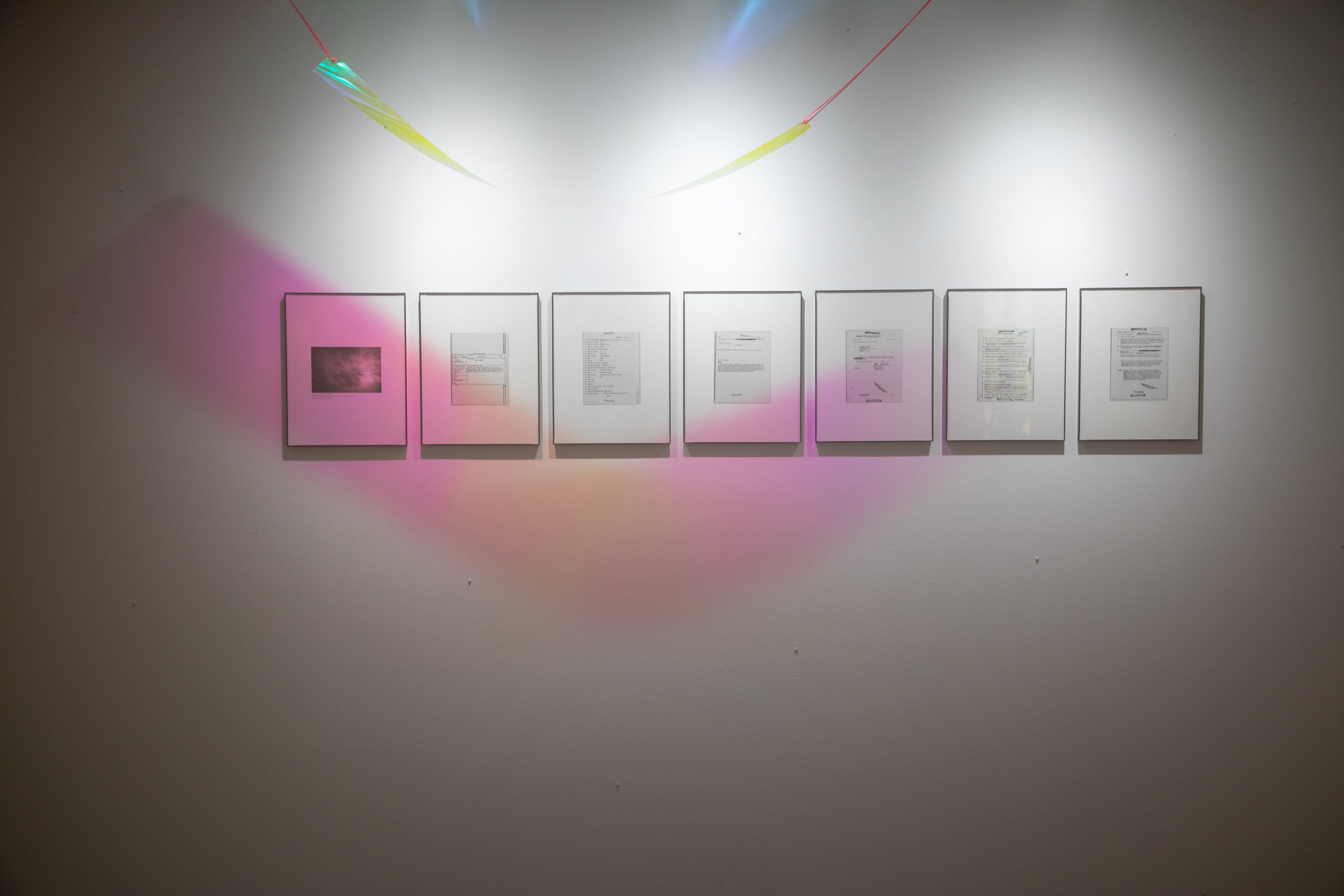JR Roykovich - Personal Works Portfolio of Major Projects for Texas A&M, 2024
Project 1:
Travel in Light Years:
Artifacts & devices adapted to
traverse the precarious spectrum
In/Between
Homofuturism and the superannuated
as an exile in a land
of glorious f/utility
Galveston Artist Residency, Galveston, TX
2022
Full gallery installation shot.
Travel in Light Years was a large solo show held at the gallery at the Galveston Artist Residency from August 27th - November 5th, 2022. This multifaceted installation with varying media was designed to interact with the natural sunlight that enters the space throughout the duration of the day. As the Earth rotates, beams of light from the sun coming through a large windows engage suspended artifacts excavated from around the gallery venue, hung using neon twine. The windows were coated with a dichromatic film that created different hues depending on light intensity, relating to the time of day. Two “sails” are at either end, and were billowed by hanging box fans. A fog machine was suspended with the artifacts to provide a density to the air, allowing the light to be opaque.
Working in installation, I generally rarely make individual pieces of art, instead opting to work by project, where many different facets of media come together to make one whole. The work utilizes photography, video, mark making, performance and installation to document and explore psychic environments of intersections, systems and networks through time while using myself as a queer coded conduit. For this particular body of work, I was working with the site to explore an idea “interplacement,” or what it is like to embody realities at different points in time. The majority of artifacts in the piece were excavated from open building sites from around Galveston Island, where it is incredibly easy to find a material history literally just below the surface of ground. Those artifacts were then hung in the shape of a vessel, a device to help traverse a voyage of inner and outer space. Using this vessel, it is an exploration that results in a large mapping based off of environmental recollection which serves as a nerve center to explore, document, and connect various personal and collective histories.
Total Gallery Space: Approx. 42' x 32' x 14'
Artifacts are also placed on 3' x 6' x .5" sheets of plexi, coated with dichromatic film which further reflect and refract the beams of light as they come into the gallery space. This view is when the light is coming from the west, towards the end of the day.
As the afternoon sun came into the gallery space through southward facing windows situated towards the ceiling, yellow-hued light would interact with displayed artifacts laid out on sheets of plexi, reflecting the rays. All these transparent surfaces were coated with a dichroic film that was both super reflective and changed color depending on light intensity. All artifacts were mined locally, from dig sites around Galveston Island, giving clues to the history of inhabitance: scraps of metal used in shipping, horseshoes, iron signage, railroad spikes and so on.
Early morning sun entering the gallery from the east, with fog machine on.
A closer look at some of the artifacts displayed in the installation. This image was taken at night, when no outside natural light was interacting with the dichroic-film-coated-plexi “shelves”. All artifacts were mined locally, from dig sites around Galveston Island, giving clues to the history of inhabitance: scraps of metal used in shipping, horseshoes, iron signage, railroad spikes and so on.
The show also had a series of fifteen (15) printed photographic images, each 24” x 36”, on Epson Metallic Gloss, mounted on wood. These images were digital scans of 3200 speed 35mm film negatives. The images were of locations surrounding the installation site on Galveston, purposefully taken out of focus at night, using a very wide aperture. Installation photograph with fog present from fog machine elsewhere in the installation.
The photographs in the show were hung to follow the sunlight as it moves around the space. The metallic surface of the photographic paper then reflects light from the sun as it moves.
For a long time now, in my practice, I have utilized a ghost-hunting device known as an Ovilus. The Ovilus device purports to read electro-magnetic fields from surrounding physical space, and then responds with a voiced, phonetic word based off of those readings. I gather those words while I am working on and installing the work, list them, and then print them out. Here they are shown mounted on a large wooden board (8' x 4').
I have an ongoing series of work that I am currently working on where I research and then visit sites across the United States that are listed in the unclassified Project Blue Book documents. Once at the site, I take a photo of the sky to relate back to the files. This series of framed unclassified documents are from a report on Galveston Island. A piece of dichromatic film is hung in-between the lights in the gallery and the documents to cast a hued reflection.
Along with the excavated artifacts from around Galveston that were hung with neon twine, secured with clamps, I use suspended a series of motorized disco balls, at speed of 6 rotations per minute.
Here, the end of day sun enters the gallery, causing rays of light to stream in the the westward facing windows.
Timelapse of light moving throughout the gallery during the day, starting early morning and finishing in late afternoon.
Press for Travel in Light Years (each photo is linked):
Project 2:
In/Between | A Rock and a Hard Place:
Visions from the Ghost World of how to Survive One’s Sovereignty of Self Destruction in a Land We Assumed We Once Knew.
Rice Media Center, Rice University, Houston, Texas
2019
This image served as a cover image for press, postcard mailers and outreach - pigment print of a digitally scanned 35mm film negative.
Installation view 1, night: Holofilm window film tinting, digitally printed transparencies, wooden pallet, found objects with salt crystals grown on them. In background right, pigment prints, approx. 82” x 42” and approx. 30” x 12”. In background left, digitally printed vinyl wall covering, approx. 16’ x 4’, and transparency, approx. 3’ x 7’.
Installation view 2, night: Holofilm window film tinting, pigment prints approx. 48” x 36” and approx. 12” x 24”.
Front forward installation detail, with daytime view on top and nighttime view on bottom. A holofilm was placed on the windows that allowed a viewer to see outside the gallery while the sun was out, but then turned the windows into a mirror after the sun set. Materials: Holofilm window film tinting, digitally printed transparencies,wooden pallet, found objects with salt crystals grown on them, salt crystal basin.
Displayed objects were excavated from open building sites in and around the Rice University campus. These objects were then immersed in a highly concentrated salt solution, where crystals were allowed to grow.
Burning Bush/Scorched Earth/Beginnings and Endings. Triptych of three 24” x 36” digital pigment prints. Part of a photographic series documenting wildfires in West Texas in the summer of 2018.
Arrivals I. Pigment print of hand developed black and white film, mounted on wood. 12” x 12”.
For the past several years, I have been exploring different landscapes within the United States, particularly within the National Park system. I am very interested in what these places mean not only in terms of a current American psyche, but also for myself as a queer entity traveling through them in this specific time period. Most of these landscapes were once as foreign to me physically as they were psychically, as alien as a literal other world - even as an American who has had the persona and ideology of these lands fitted to me like a second skin by a tailor of colonization - like, I should say, most other (perhaps mostly white) Americans. I use the landscape to dive into the foggy earth of consciousness, as a familiar yet foreign experience to explore how our environments shape who we are on a psychic level. This is especially of importance in this current American era, as the attempted growth happening in the United States remains so divisive. While progress flows in and out like a social tide pulled by the gravity surrounding political reality stars, the landscape remains as an ideological mass that defines & defies the nostalgia of what America claimed to be and what it could be still.
Future Artifacts. Triptych of three 24” x 36” digital pigment prints. Part of a photographic series documenting the logging industry in the Pacific Northwest.
U.S./Mexican Border Wall, Sunland Park, New Mexico. Pigment print, 24” x 36”, mounted on wood. Installation with wood and holofilm.
In Sunland Park, New Mexico there is a section of the United States/Mexico border wall that was initially constructed during the Bush administration. A further expansion of this portion of the wall was privately funded in 2018 by a GoFundMe campaign that raised over $22 million dollars from donations, to be built on privately owned land. This section of the wall has since been in contention between the private builders and the federal government due to claims that parts of the wall block access to International Water and Boundary Commission sites as well as “International Boundary Marker 1,” registered on the United States National Register of Historic Places. It also seems, based on statistics of migrants crossing at this particular area of the border, to have done little to actually curtail undocumented border crossings.
Sliding through planes / Folded InBetween dimensions. Pigment print of hand-developed color film, 48” x 360”.
On Being In/Between
Justin Raphael Roykovich describes the past five years of his life as nomadic. This is a common reality for artists piecing together residencies and teaching jobs as they try to find a homebase while embracing the freedom of not being tied to one. Roykovich has worked in New York, Washington, DC, Minneapolis, and most recently Galveston, Texas. The Galveston Artist Residency gave Roykovich a studio, and for a year he found grounding. I use the word grounding intentionally because his culminating exhibition at the residency largely consisted of objects unearthed from a nearby construction site. Currently Roykovich teaches at Rice University in Houston, Texas, and he is reflecting on his travels through the state of Texas and his time in “The West” -- a historically mythic, grandiose place.
Roykovich’s installation at Rice University’s Media Center presents his impressions, recollections, and readings of the Texas landscape through photography, drawing, found objects and text. It is a compilation of places assembled into a psychic map that volleys between the specific and the abstract. An enlarged photograph tiled on a wall legibly captures a rock surface, but viewed up close it could look like a fuzzy broken image, digital glitch or interference. Roykovich’s drawings, done in the studio removed from the landscape, look like geological strata quilted together, sliding down the page, aerial views of land meeting water, or hypnotic mark making.
Many of us in a nomadic state may simply fixate on our destination as we travel from point A to point B, but Roykovich gravitates to the in between places. He uses this phrase, the “In/Between” in his exhibition’s title, and he writes about how the term defines his relationship to reality as “part removed, part immersed and always existing in a space of my own.” I write this essay in my own “in between” state. A former resident of Houston now living in the greater Boston, Massachusetts area, I rely on email exchanges, written descriptions, digital images, and sketches to understand an installation Roykovich is in the midst of preparing to compose largely onsite in the Rice University Media Center gallery space. I can sometimes imagine myself in or navigating his installation, but I can never actually see it or experience it. I only mention this fact because this predicament feels fitting for writing about an artist who wants to place us inside of his experience of the Texas landscape, an experience that may at once feel familiar to people who have spent time in Texas, but at the same time made strange through Roykovich’s distorted lens.
Instead of simply passing through, Roykovich takes the time to look, listen, and record his observations of these in between places, many of them non-descript or seemingly empty. He uses an electronic device called an Ovilus 5 that ghost hunters and others who wish to communicate with spirits use to generate long strings of text that the device spits out as it purportedly picks up the voices of the dead. The Ovilus 5’s readings become found poems that Roykovich mixes with his own words that relate to research he has done about a particular place or his immediate observations. In Roykovich’s hands, the Ovilus is not a literal tool or transmitter, but a metaphorical device. It is a symbolic instrument that shows the seemingly empty as something full of invisible energies and the superficially non-descript rich with hidden stories, often involving murder and trauma. He has traveled through Galveston, a place often described as haunted, as well as “The Texas Killing Fields,” a stretch of the I-45 corridor between Houston and Galveston where since the 1970s the bodies of 30 unsolved murder victims have been found. He does not assert that he has necessarily captured the voices of the dead, but that instead he has found a “a way to let that environment, which otherwise could not be accessed, have a phonetic voice.” He continues to explain:
“I am curious as to what the land has to say, as particles and atoms and molecules that have been around since The Big Bang. What can it tell us about where we are now? What if we had listening parties on lands that are scared from trauma, or have held sacred rituals - what would the land tell us? … What we perceive as the banal and ordinary landscape of our daily lives is actually teeming with morsels of discovery like grubs emerging from the dirt.”
But unlike a traditional landscape painter setting up their easel to capture a sublime piece of Western landscape before their eyes, Roykovich gives equal weight to the seen and unseen elements he finds in a place, holding them in a vibrating state of tension. An example of this is a 44” x 20 photograph snaking through the gallery space. Reading it from left to right, the image unfolds out before us to show a mountain ridge’s silhouette interrupted with intense bands of bright red and yellow. The bands of color look like solar flares where the camera becomes flooded with light, overwhelmed by the brightness of the sun and yielding to an unseen intensity and force.
Part of Roykovich’s intentions is to forge a deeper connection to places we may take for granted and that are rapidly changing because of climate and social change. He wishes to draw our attention not simply to the grandeur of a vista -- an impulse that could easily slide into a nature worshipping cliche -- but instead to the buzzing magnitude and mystery of basic reality. Influenced by theoretical physicists writing about the nature of reality and origin of the universe, he describes the neon strings he often uses in his installations as “materializing the hidden latticework that keeps our reality upright from collapsing.” The strings could be fiber optic cables, rays of light, a photon’s path of travel, and a very literal nod to string theory. It may sound exhausting to imagine every slice of reality as teeming with possibility, but it is much better than the alternative. Roykovich’s desire to observe and listen to the places that may not be culturally demarcated with historical plaques or set aside as important, is a cure for the malaise that could set in when you may feel stuck in the middle of nowhere. It is a reminder that we are always somewhere that has a story to tell, but how we access that story is the creative act.
Project 3:
Systematic Magic
Galveston Artist Residency, Galveston, Texas
2019
Detail view, left side of gallery; 4’ x 8’ table suspended from ceiling using neon, nylon line; table covered using orange bubblewrap with salted artifacts placed on top and suspended above.
Detail, found beach detritus: catfish skeleton with salt crystals.
Detail view, right side of gallery; 4’ x 8’ table suspended from ceiling using neon, nylon line; table covered using orange bubblewrap with salted artifacts placed on top and suspended above.
Detail view, found beach detritus and excavated artifacts with salt crystals.
Systematic Magic:06 - On the Shore. Site exploration documentation of Galveston, Texas. Pigment print on Hahnemuhle Photo Rag, mounted on wood, 24”x36”
Detail view of palm fronds hung from ceiling; there was a sprinkler system installed with the fronds so that salt water would consistently drip down the leaves and onto the floor of the gallery for the duration of the show. The sprinkler system pulled from a vitrine of salt water placed between the two floating tables.
Three 12” x 9” drawings mounted on 16” x 36” wood, covered with plexiglass, held in place with clamps. Gel pens and marker on bristol board. Salt buildup on plexi throughout duration of show.
Project 4:
MCMLXXXIX / The Vogue Redux, Part 1
Gillespie Gallery of Art
George Mason University
2010.
A note about this work: The following essentially constitutes my undergraduate thesis. I was a non-traditional student, and finished my undergrad when I was in my late 20’s. In many ways, I consider this work my first body of “serious” work as an artist. However, since it is now almost 15 years old, I normally would not include this work in a portfolio; yet it is a body of work focuses primarily on video installation, and that also uses interactive technology. Further, it is a body of work that I am now getting back to in many ways, not so much as far as content, but in terms of structure - the written part of my thesis, a short but heavily researched essay titled “The Redux as Redefinition”, was picked up by a couple small academic journals meant for undergraduate work. I plan to get back to deeper writing in my practice, using this older work as a template.
Further, the video work is rough; it possesses a lack of refinement in editing that is obvious. However, it was still noted; I submitted it to the Vimeo Festival and Awards, which was a 3-day international showing and conference in New York of internet-based video, juried by heavy hitters like David Lynch, among many others. I had no expectations for the piece when it was up against such professionals, but it ended up shortlisted. It was quite an achievement for me at the time, having just come out of my undergraduate career.
This piece was submitted to and short-listed for the 2010 Vimeo Festival and Awards, under the documentary category.
A short essay I wrote in conjunction with this piece, titled “The Redux as Redefinition”, was published in a journal called Sprinkle: A Journal of Sexual Diversity Studies, Vol. 4, December 2011. The journal as put out by The Paulo and Nita Freire International Project for Critical Pedagogy. I have included my excerpt below, and there is a link to download the entire journal, if desired. (I realize the photos are small.)








Installation Shots:



